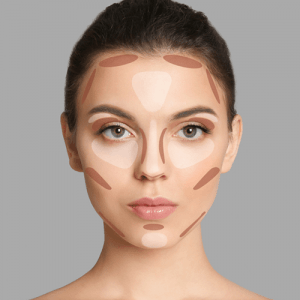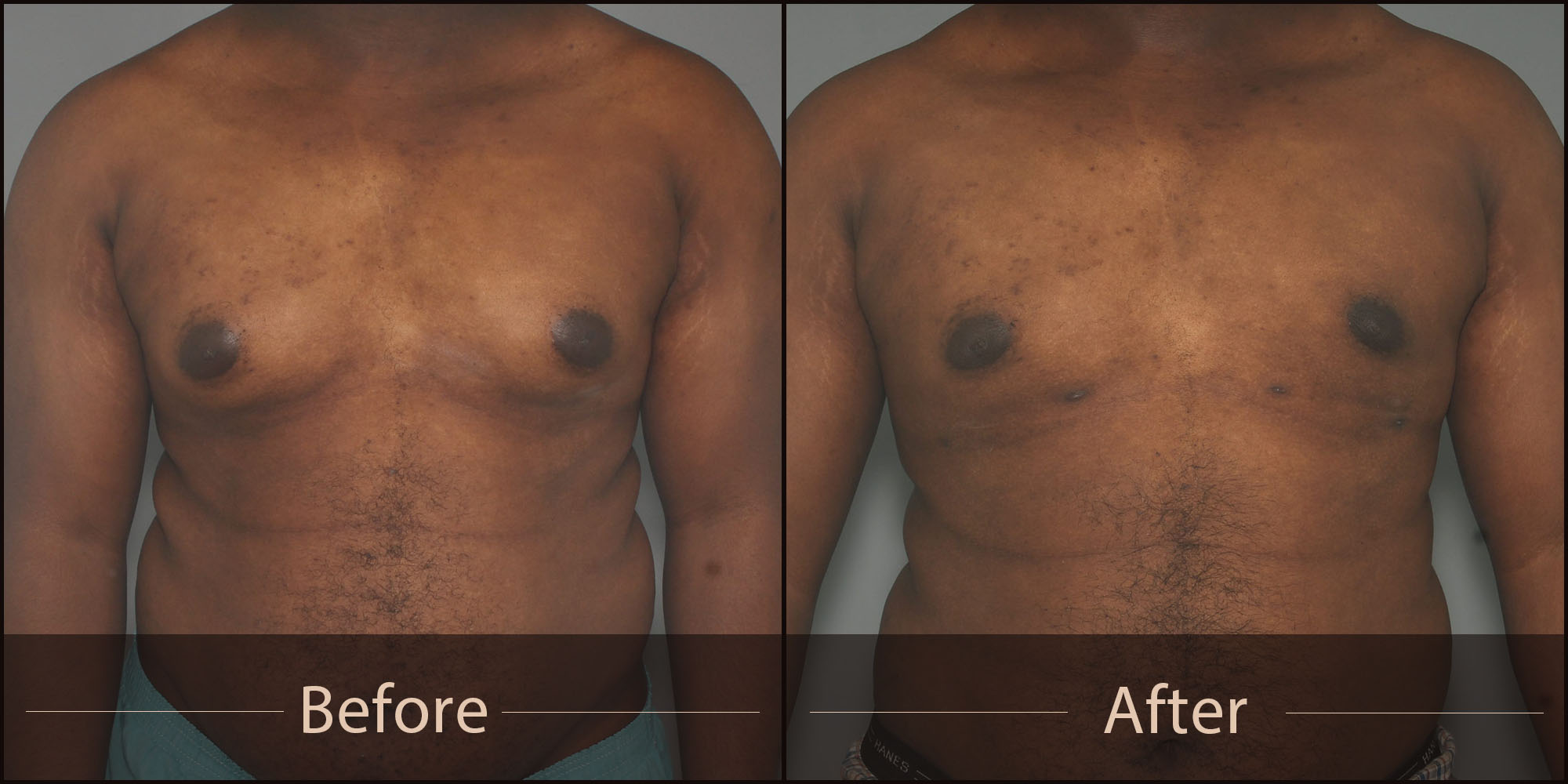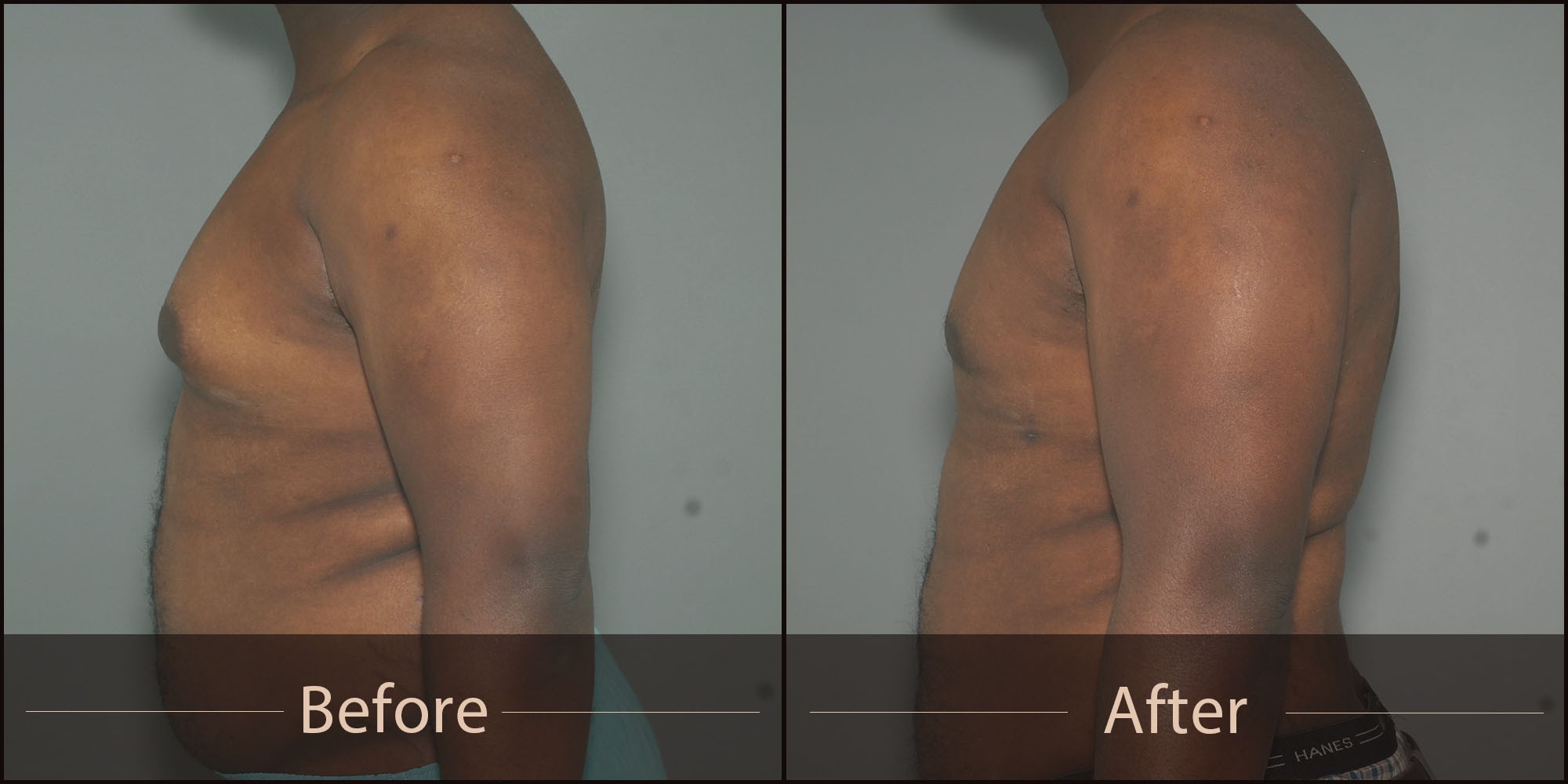Gynecomastia Surgery
What is Gynecomastia?
Gynecomastia is excessive breast development in a male. It is generally an aesthetic problem, but occasionally, the breast can also be painful. About 30% of males going through puberty develop mild gynecomastia. Almost always, this excessive breast tissue will subside within a couple of years.
What Causes Gynecomastia?
Gynecomastia can accompany the onset of puberty but usually fades away after a couple of years. This is related to the generation of sex hormones and the breasts’ new exposure to these agents. As puberty becomes complete, the hormones come into balance and the breast tissue responds to the predominance of testosterone over estrogen (yes, men do have some estrogen).
Gynecomastia can be a byproduct of anabolic steroid use. It can be seen in heavy marijuana users as this drug can lower testosterone levels. It is seen as a byproduct of some medications (spironolactone). Alcoholics can develop gynecomastia as damage to the liver decreases its ability to breakdown estrogen which may stimulate breast growth.
Aging can bring about the development of gynecomastia as testosterone levels fall. There are also some rare tumors of the endocrine system that produce estrogen and cause the problem. These are quite rare.
The development of gynecomastia after puberty is, most of the time, idiopathic. That is, we really don’t know what causes it. It is usually bilateral but can be a problem on one side or the other.
Stages
There are different several different published grading systems for gynecomastia. The classifications are related to the amount of excess breast tissue and excess skin.
- Grade 1: The breasts volume is small (but still visible) and the skin is not in excess
- Grade 2: The breasts are significantly enlarged but excess skin after removal will not be a problem
- Grade 3: The breasts are large and excess skin will be a separate aesthetic issue after removal
- Grade 4: The breasts are large and not only is there excess skin but the areola has descended and will require repositioning at the time of surgical treatment (the condition is referred to as ptosis)
Male Breast Reduction Surgery
In those instances where the breast tissue does not naturally disappear, or if gynecomastia appears for other reasons, surgical treatment is warranted. There are different operative approaches to solving gynecomastia. Dr. Zubowicz will present suitable surgical options depending on the type and magnitude of the breast development.
The breast in a male or female is a combination of fat and glandular tissue. Most of the time, the operation to remove the gynecomastia combines liposuction (to remove the fat) and surgical excision (to remove the glandular tissue).
If the breast is substantially composed of fat with little glandular tissue, liposuction alone may treat the problem. However, since liposuction does not remove glandular breast tissue, any substantial amount will require excision. Using a more aggressive liposuction technique, small amounts of glandular tissue can be removed. This allows a satisfactory result by liposuction alone in about 50% of cases. The other half will need direct surgical excision of breast tissue in addition to liposuction.
What to Expect During the Procedure
About half of my cases are performed in our office operating room with oral sedation. The chest is anesthetized with tumescent fluid (salt water with lidocaine and epinephrine added). Breast tissue is a combination of fat and glandular tissue.
The chest undergoes liposuction first. Occasionally this is the only treatment needed.
After liposuction, if there is significant amount of breast glandular tissue this is removed by an incision along the edge of the areola. A pressure dressing is then applied.
Not all gynecomastia patients are suitable for outpatient surgery and will be operated upon under a general anesthetic. Depending on the complexity of the case, the operation lasts from 1 to 2 hours. Drains are seldom used and patients are expected to be up and about immediately.
Surgery Recovery
A pressure dressing is in place for 48 hours. After removal patients can shower and wash the chest.
Small Steri-Strips cover the incision and will fall off in a week or two. Dr. Zubowicz will see the patient a week after surgery. The sutures are dissolvable so there are none to remove. If there are no complications, full athletic activity is permitted provided in isn’t painful. Most patients will wear a compression garment for several weeks primarily for comfort.
Why is Dr. Zubowicz the Best Choice for Male Breast Reduction Surgery in the Atlanta Area?
Dr. Zubowicz is a board-certified plastic surgeon and has been firmly established in the Atlanta medical community for over thirty-five years. He obtained his medical degree from University of Kansas and completed his residency at Emory University Affiliated Hospitals. He is patient and will answer all your questions. He will make you fill very comfortable and confident in your decision to move forward with him.
Gynecomastia Consultation
Schedule a consultation with Dr. Zubowicz at one of his offices in Midtown Atlanta or Milton. During the consultation, Dr. Zubowicz will discuss your goals, explain the process and determine if you are a good candidate for male breast reduction surgery.
Frequently Asked Questions About Male Breast Reduction
Written and reviewed by:
This article was written by Dr. Vincent Zubowicz, who is board certified by the American Board of Plastic and Reconstructive Surgery. He practices medicine at his offices in Milton and Atlanta. Learn more about Dr. Zubowicz, his medical training, and credentials.

Dr. Vincent Zubowicz is one of the Atlanta areas top plastic and reconstructive surgeons. He is an expert in cosmetic surgery, with years of experience performing many plastic surgery procedures. He offers a personal, customized approach and is dedicated to helping patients achieve the most natural looking results.
Call our office at 470-462-2917 to schedule your consultation with Dr. Vincent Zubowicz.
Customer Reviews









